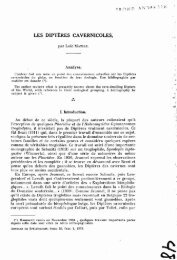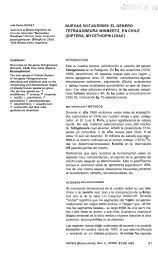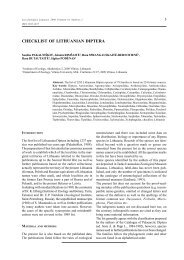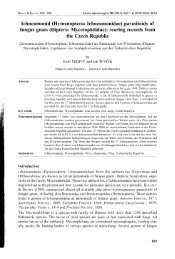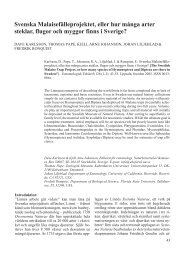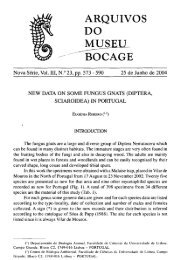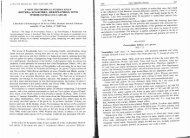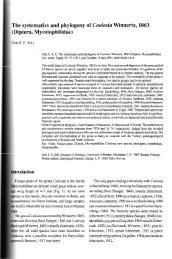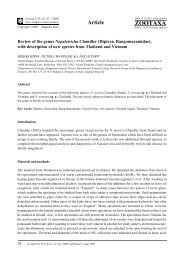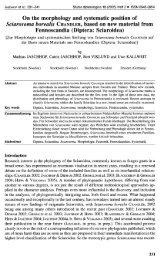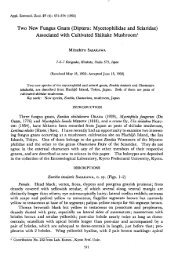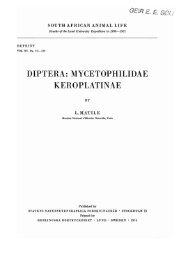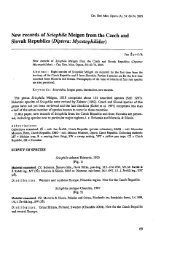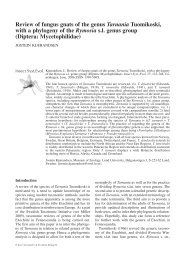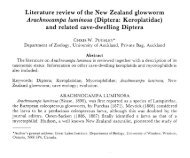Fungus Gnats - Online Identification Keys
Fungus Gnats - Online Identification Keys
Fungus Gnats - Online Identification Keys
Create successful ePaper yourself
Turn your PDF publications into a flip-book with our unique Google optimized e-Paper software.
Pp --p --<br />
P P P P P- -P- P -P<br />
P P P P- P P P P ~p~ P<br />
P<br />
p P P ~P P P~ P P ~P ~P P p~ P -<br />
Studia d~pterolog~ca 7 (2000) Heft 1 a ISSN 0945-3954<br />
<strong>Fungus</strong> <strong>Gnats</strong> (Diptera: Bolitophilidae, Keroplatidae<br />
and Mycetophilidae) from the Maltese islands<br />
[Pilzmiicken (Diptera: Bolitophilidae, Keroplatidae<br />
und Mycetophilidae) von den Maltesischen Inseln]<br />
by<br />
Peter CHANDLER and Paul GATT<br />
Uulnliam (England)<br />
Rabat (hlaltd)<br />
~- -P~-P- Abstract<br />
Key words<br />
-P<br />
AI] account is given of the fungus gnat fauna of the hlaltese islands, which was previoi~sly<br />
little Itnown. The number ofspecies recorded is increased from .3 to 30. T\vo species. .Jfarrocera<br />
husk~ftina spec. nov. and Dnrosiu ntelitir spec. nov. are described 3s new; two orhcr nr\v<br />
species were also recognised in Spanish ~nnterial and are being dcscrihcd elsewhere. Two<br />
spccles. Ec~/rc~~r~.s/lroi~
CHANDLER & GATT: <strong>Fungus</strong> <strong>Gnats</strong> (Diptera: ...) ~-<br />
from the Maltese islands.<br />
Nevertheless, the islands are surprisingly rich in fungi and somc 400 species are knonn to<br />
occur (Mr Edwin LAVFKANC~, pers. comni.). Rcaring of immature stages from fungi is therefore<br />
cspccted to yield more specics as are Malaise or water trapping in suitable habitats.<br />
A littlc rcaring has also been done. Lciu hi~~~~rc.l~l(itci l'MtI~itN) has been reared from an<br />
unidentified fi~ng~~s in Buskctt and Exechiu ,fi~l\yu S,\N-ros A~r~
Stud~a d~pterolog~ca 7 (2000) Heft 1 69-81<br />
MJE = M. .I. Ent II I{ BMNH = Naturdl tli~tor-y Museum, London.<br />
PG = P. G,\rr MNHN = Muse~~m National d'Histoire Naturellc. Paris<br />
.<br />
Species List<br />
BOLITOPHILIDAE<br />
Bolitophila p.seudo11ybrida LANDROCK, 1912<br />
Material examined: Malta. Buskctt: 27.iii. 1093, Id (PC;). 1 P (M.IE): M'ied (ihajn Rihana: 5.1i.l994, I d. I 'i (PC;):<br />
2.i~. 1004. 2 E E (PG); Wied Incila: h.iii. 1003. 2d d (PG).<br />
Distribution: widely distributed in Europe.<br />
KEROPLATTDAE<br />
Keroplatinae<br />
Antlemon (Antlemon) halidayi (LOEW, 1871)<br />
Material examined: Malta. Uuskett: 22.i\.I992. Id (MJF,): I.\.IL)C)2, 2dd (MJE): Il.iv.1994. I3 (PC;): (ihajn<br />
Iladid: 9.ib.1999. 1 P. (PG): Qamm~eh: 19.i11. 1904. 5,: i. feeding at tlawcl-a of FC,VII/(I c.o~i~irrurri, (Apiaceae)(l'(;).<br />
Distribution: a Mediterranean spccics, widespread in southern Europe and North Africa,<br />
also recorded from the Canary Islands (CI-IANIILCR & RIBEIRO 1995).<br />
Pyratulu ehroensis CHANDLER & BL~SCO-ZURTETA<br />
Material examined: Malta. Buskett: I.\, 1992. 4d d (bllt-); I I.I\.I')~)~. 58 6 (PG); Ghajn Hadid: 9.iv.l999, Id<br />
(PC;): Mgiehali: 23.1v.l994. 81 d. 227 (MJF;. PG): 20.111.I~)~)5. I \' (MSFI. M'lcJ Cili;!jn Rihana:2.i\.1Oi)1. I (l'(;).<br />
M'letl il-Qlejghn, 8.xi. 1'192. I d (MJF): Wicd ijanncitta: I .I\. IC)W. 2,3 ,? (PC;): IO.iv. 1993. I d (M.IE). Gofo. Ramla<br />
dunes: 23.1\.lW2. 1.3 (['C;)<br />
Distribution: this species is currently being described from Spanish material collected in<br />
the arid Monegros region of Zaragoza Province (CH-ZNDLER & BLASCO-ZIJMET.A [in press]).<br />
Occurrence in Malta suggests that it may also be present in North Africa.<br />
Remarks: It belongs to a group of species closely allied to the ividespread European spccics<br />
P /~r/y)~r.rilltr (ED~~ARDs). of wliicli there are several in the Mediterranean region; P OI-ULI(.II/LI<br />
CHANDLER from Greece and Israel (CHANIIL~.R 1994) and P L.UIIUI.~~ICHANIII~~I~ & Rrl3t.1~0<br />
from the Canary Islands (CHANDLER & RIBEIRO 1995) belong to this group as ivell as species<br />
from Greece and Switzerland described in CHANDLER & BLASCO-ZUMCT,\ [in prcss].<br />
iVL.oplutyura biurnbrutu (EDWARDS, 1913)<br />
Material examined: Rlalta. Bal~an: 28.11i.1077, I ? (MJI:): Uuskrtt: 1.v. 1992. 2$ d (MJI-) 2$ $ (PG): 27.i1i.1903.<br />
5$ 3 (MJL:). 5c' .c. I k' (PG): 1 l.iv.1994, 3d d (PC;); 25.iv.1994, 1 d (MJE): Fiddicn: 1 l.v.1992. Id (MSE): Wicd<br />
Babu: I.lv.199.7. 1 P (b1JE). l E (Pi;): Wicd iihqn Rihana: 2.1v.1994. 3$ d. 1 P (PC;): Wied il-Mistra: 19.1i1.19')3.<br />
Id (PG); WieJ 11-Qlqgha: 8.xi.1992. 1 2 (MJE); Qarnmich: 19.iii.1')94, 1 P (PG). Gozo. Dahlet Qorrot: 2.i\.l')93.<br />
2$ $, I P (MJL):TJ'CCI~C: I.iv.1004, I d (MJE): Mgarr ix-Xini: 23.iv.1992, 1 d , 1 O (MJE).<br />
Distribution: western Europe: Britain and France, an unpublished record from Sicily (Dr<br />
Norbert CASPEKS, pers. comm.).<br />
Macrocerinae<br />
Macroceru buskettinu spec. nov.<br />
(Figs 1-3)<br />
Description: A small, mainly brown, slender bodied species with unmarked wings bearing<br />
extensive inacrotrichia on the membrane. Wing lcngth 3.3-3.6 mm (male) and 2.7-2.9 iiini<br />
(female).
pp-<br />
CHANDLER & GATT: <strong>Fungus</strong> <strong>Gnats</strong> (Diptera: ...) from the Maltese islands.<br />
--.-p pp<br />
Figs 1-3: .2/oc,vcerrr I~ii.s!ietri~iu spec, nov., male genit~~lia. - 1: dorsal view with terglte 0 and ccrci removed: - 2:<br />
tergite 9 and cerci: - 3: I;~teral view of gonostylus. Scale = 0.2 rnln.<br />
Male<br />
Head dark brown. Antenna light bro\rn, paler on scape and pedicel. Flagelluln slender, but<br />
most missing in holotype (complete in paratype); antenna a little shorter than body length<br />
(as in related species). Palpus br0n.n.<br />
Thorax mainly brownish yellow, with three shining dark brown stripes on niesoscutum, the<br />
anterior stripe broadened to the fore margin, the laterals postsutural only, leaving a broader<br />
humeral area and narrow side margins of mesoscutum yellow. Pleural sclerites and mediotergite<br />
shining dark brown on disc. Thoracic setae dark, including short scutellar marginal<br />
setae. Legs long, slender, yellow apart from brownish shade on outer face of coxae 2-3, with<br />
dark setulae and hairs, all those on tibiae shorter than tibial width. Tibial spurs short, 1 :2:2,<br />
about as long as apical tibial width. Wing clear, narrow on basal half. Costa and radial veins<br />
brownish. Wing membrane bears macrotrichia scattered over most of surface, but absent in<br />
cells c, sc, r, and r, and sparser on basal part of wing. Vein Sc ends just beyond level of base<br />
of Rs. Vein R, begins level with tip of R, and is short, curved and setose. Vein R> convergent<br />
with costa apically. Costa extends 0.4 distance from R, to M,. Haltere brownish yellow.<br />
Abdomen mainly brown. Tergites 2-6 with apical third yellow. Genitalia (Figs 1-3) brownish<br />
yellow. Tergite 9 broad, narrowed medially in holotype (Fig. 2) but more elongate and as<br />
long medially as cercus in paratype. Cercus narrow and tapered on apical half. Gonostylus<br />
elongate and irregular in shape, with some dense setae but not toothed (Fig. 3).<br />
Female<br />
Similar to male in most respects except that vein R, is weakly developed (absent on one<br />
wing in one specimen and incomplete in the other). Abdomen dark brown with tergites only
Stud~a d~pterolog~ca 7 (2000) Heft 1 69-81<br />
b<br />
vaguely yellowish apically. Tergite 7 and short tergite 8 all brown. Ovipositor yellowish;<br />
cercus sinall, ovoid.<br />
Etymology: This species is named for the locality, which has proved most productive of<br />
fungus gnats in Malta.<br />
Material examined: Hulotype d : Malta: Buskett. l .v. 1992, M. S. Eul JLI~<br />
leg.. depos~ted In BMNH. Paratypcs: I d:<br />
Malta: C;ward;l~nang~a: 18.ii1.1902, M.J. EUI ~t r leg.; I P : data as holotypc (st:lgcil with it), tleposited in BMNH: I 0 :<br />
Malta: Buskctt: 22.i\.!YY2. M. S. ERI-JI.K leg..<br />
Remarks: This species agrees in external characters with several species from the eastern<br />
part of the Mediterranean region, four of which were described by CHANDLER (1994) from<br />
Israel and a fifth from Bulgaria by BECHEL. ( I99 I ). In the form of tergite 9 and cerci and the<br />
absence of teeth on the gonostylus, it most resembles M. levantina CHANDLLK from Israel but<br />
differs in the form of the gonostylus and aedeagus; the cerci are also narrower.<br />
Macrocera fasciata MEICEN, 1804<br />
Material examined: Malta. Buskett: 14.iv.1077, I d. I ? (MJL'.); 22.i\.1002. 5d d (MJE); I.v.19')Z. I d (MJE),<br />
26 d (IT;): 27.iii.1994. I d (PG); 12 1v.1994, 2d d (PG): Girgent~: 1X.iv.10c)3, I d, 1 P (MJE); Wicd Qannotta:<br />
1 .]v. 1004. l d (PG).<br />
Distribution: widespread in Europe: Canary Islands and North Africa (CHANDLER & RIUIIIRC)<br />
1995), Crete, Cyprus and Israel (CHANDLEK 1994) and Oman (CHANDLER in press).<br />
Macrocera parcehirsuta BECKER, l908<br />
ivlater~al exam~ned hlalta Mletl ln~~la 6 111 1Y04 Id (PL) Go~o h~cd II-MICI~II~ 70 \I 1001 2: (kf IF )<br />
Distribution: described from Algeria and only otherwise confirmed from Israel by CHAN-<br />
DL~K (1994). who figured the male genitalia and gave the distinctions from M. phcrlemta<br />
MFIGEN, with which it had been confused by some authors.<br />
Macrocera phalerata MEKEN, l818<br />
Material examined: Malta. BusLctt: I .v. 1992, I d. I 'l (hlJE). Id (PG): 18.xi.1993, 1 ? (MJE): 27.iii.1004, l d<br />
(MJE), I ? (PG): Fawwara: IX.i1i.I002. 2J 3 (MJE); Fiddien: 5.i.1992, Id (MJE); Marfa R~dge: IL).ili 1904. 1 P<br />
(PG); Mgiebah: 26.iii. 1995.26 d (hlJE). I 'i (PC;); Migra I-Ferha: Z.iv.1999, l d (PG); M~rieb: X.xii.1093. 1 d,4? P<br />
(PC;). I P (MJE); Qa~nmich: 10.i1i 1994. l ? (PG): Wicdil-Mistra: lO.ili.1994, 1 P (MJE): W~edil-Qlcjgha: 0.ii.1994.<br />
I P (MJE): Wied Incita: 6.i1i. IYC)4. 1'1 (MJE): Wicd Qannotta: 20.ii.I994.2,3 d, 1 2 (PG), I i' (hlJF). Gozo. Mgarr<br />
IX-Xini: 23,i\.l002. 19 (PG): 28.\i.lc)Y3. l P (PC;); W~ed ir-Ramla: 10.i\.10L).7. 2T 7 (PG).<br />
Distribution: widespread in Europe and around the Mediterranean, including Tunisia and<br />
Israel (C~IANI)LFR 1994).<br />
Macrocera pusilla MEICEN, 1830<br />
Material examined: Malta. Bahrija: 4.viii.1992, Id, 2Y P. at light (PC;); Rabat: 20.vi.1995, 1 P, at I~ght. (PC;):<br />
Salina: 7.vii.1993, I d (PG); Wied Qannotta: \ii.1995, 15 (PG).<br />
Distribution: widespread but local in Europe; Israel, Iraq, Egypt, Tunisia (CIIANOL~K 1993)<br />
MYCETOPHTLTDAE<br />
Mycomyinae<br />
Mycomya prominens (LLINDSTRORI, 1913)<br />
Material examined: Malta. Uahrija: 2.1i.1994, l ? (MJE): Buskett: l.\,.1992, 19 (MJE); lX.xi.1993, 286, 19<br />
(PG). I P (MJE); 29.xii.1993, 2? i' (PG); Fawwara: lX.i~i.l~)YZ. 14.29 P (MJE); G~rgenti: 2O.xi.l99l, 16 (M.IE);<br />
M'icd Babu: l .v.1993. I P (PG); Wied Ghajn Rihana: 2.1~. 1494. 16, 2 P 2 (PG); Wied il-Mistra: lL).iii.1994, 1 i'<br />
(MJE), 12 (PG): Wled Incita: 27.ii.1994, l Y (PG): 6.iii.1994, 2? P (M.IE). 1 P (PG); W~ed Qannotta: 2O.ii.1994.<br />
2 2 2 (PG); l.iv. 1994. 1 P (PG). Gozn. Mgarr ix-Xini: 28.xi. 1993, 1 ? (PG).
CHANDLER & GATT. <strong>Fungus</strong> <strong>Gnats</strong> (D~ptera. ) from the Maltese Islands<br />
pp -p- P- P pp pp-<br />
Distribution: a common and widespread European specles; recorded from Israel, Cyprus.<br />
Crete. Corfu and Cephalonia by C~I~NDLER ( l994 1.<br />
Sciophilinae<br />
Acnc.rnia anloerra WINYEUTZ, 1963<br />
hlaterial examined: hlalta. Bukett: 22.i\'. 1992,2Ti Ti (MJE); 15.\,i1i.1992. 1 ? (1%); 27.iii. 1994.36 .3, 1 2 (MJE).<br />
14. I9 (PC;): 2i.i\.1994. 16 (MJEI: Rnhat: iii.lOQ8. l ?. at window (PC;).<br />
Distribution: wlde5pread but scarce in northern and central Europe, also recorded from<br />
Japan and CHAYIII I R (1094) added records for lsracl and the Mediterranean part of Span.<br />
Sciopkilu iheroluteu CI-I.ANI)I.EU & B~..~sc.~-ZUR.IETA<br />
Ilalerialesamined: Malta. Llalr;ln: 3.~1902, I9 (MIE): 25.xi.1003. l Y (M.IE); t3irkirl~11.a: 16.v.1079. 1 (S. S(.III.I\II
Studia dipterologica 7 (2000) Heft 1 : 69-81<br />
Figs4-S: Wings -4: E c ~ t ~ ~ c ~ ~ ~ c ~ . ~ t ~I)U / ~ \I
~ p- P<br />
~<br />
-p pp- view.<br />
CHANDLER & GAT: <strong>Fungus</strong> <strong>Gnats</strong> (Diptera: ...) from the Maltese islands.<br />
1 Female: Very similar, but<br />
pedicel of antenna yellowish<br />
brown in contrast to rest<br />
of antenna, which is black.<br />
Coxae 2-3 more narrowly<br />
dark basally and trochanters<br />
dusky yellow. Ovipositor<br />
short, brownish.<br />
Etymology: the Latin name<br />
of the island of Malta, a<br />
noun in apposition.<br />
Fig. 6: E
-P-<br />
P<br />
Stud~a d~pterolog~ca 7 (2000) Heft 1 69-81<br />
Figs 7-11: Doc.o.siu ~rrc,li/u spec. no\., male genitalia - 7: ventral view of gonocoxites and lcft gonostylus: - 8:<br />
posterior view of gonocoxites and gonostyli; - 9: tergite 0; - 10: aedeagus; - 11: cerci. Scale - 0.2 mm.<br />
I d (MJE): IX.xi. 1993, 2 d d (PG); I 8.ui. 1993. one$ reared frorn an unidentified fungus in a rot-hole iii a tree, tllc<br />
larva spun a silk web inside vch~ch it pupated on 9.xii.1993 and the adult emerged on 13.xii.1993 (PG): 25.iv.1094.<br />
2d d (MJE); 5.vi. 1994. 1 d. 1 P (PC;); Fiddien: 15.iv. 1992, I S (PC;); 10- I I .v. 1992. I 8 (MJE), I 8 (PG); Girgenti:<br />
3.iii.1991, Id; 10.xi.1901, 23 3 (MJE); Migral-Ferha: 2.iv. 1999, I nf (PG): Wied Babu: 26.ii.1978. 13 (S. Sc III hini
CHANDLER &GATT <strong>Fungus</strong> <strong>Gnats</strong> (D~ptera ) from the Maltese ~slands P<br />
Distribution: a \v~despread and common Mediterranean species, occurring In southern Europe<br />
as &ell as Turkey. Israel, Cyprus, the Greek islands, North Africa and the Atlantic Islands.<br />
E.uec/ziu .fuscu (MEIGEU, 1804)<br />
Material examined: Malta. Bajda Ridge: 26.xi1.1975, 1 P (M.IE): Bu\kett: I.v.Ii)O2, 3d d. 3Y 9 (MJI:). 36 d. 1 $<br />
(I'C;): W~cd Incita: 5.i.1987. 1 i? (MJI:).<br />
Distribution: a very common Holarctic species. including the Mcditerraneun region, North<br />
Africa and the Atlantic Islands.<br />
hlatcrial examined: hlslta. Buskctt: 5.\11 IL)91. I > (MJF): Wictl (;hajn K~hnna: 2.iv.1004. Id (P(;). Go~o l\'iecl<br />
il-l-unzjata: 21 .1\.1994. l (MSF.).<br />
Distribution: widely distributed in Europe; not previously reported from the Mediterranean<br />
region, but there is an unpublis1it.d record for Sicily and C'HANDLLK & RIBEIKO (1995) recorded<br />
it from the Canary Islands.<br />
Llalerial examined. Malta Wied Gh;!jn RiIia11a:rrll<br />
1 ri (MSE).<br />
Allodiu (Allodiu) orriuticollis (MEIGEV, l81 8)<br />
t I/CJ;CII. 3.1ii. 1007. 1 1 (MJk).(i070. \1 icd ir-K;l~llla: ?.\l1 1992.<br />
Distribution: a ~idespreud Holarctic species, also occurring in the Atlantic Islands.<br />
Brevicornlr irzterrrredir~rri (SA\ 1.0s ABIIEL, 1920)<br />
Xlaterial examined: Malta. Huskctt: 12 i\.1002. 1 S (MSE); I.v.1992. 2 i 3. I 2 (hlSF): I l.iv.1004. Id (PG).<br />
Distribution: widespread in Europe; this species was described fro111 the Atlantic lslands<br />
and CHA~I)I t~< (1994) recorded it from Israel, Corsica and Mallorca; CHAN[)L~I< & RII~L.II
p- -<br />
Stud~a d~pterolog~ca 7 (2000) Heft 1. 69-81<br />
Phronia from the closely allied genus Tt-ichoi~tn. A few Trichoiitrr species have the posterior<br />
fork shorter than the median fork but no species hitherto referred to Trichotittr has the fork as<br />
short as in some of the present material. Also intraspecific variation of the type found here<br />
has not previously been recognised.<br />
The identification as 7: icet~icu is based on thc structure of the male genitalia, which agree<br />
with British and Spanish material examined in all significant respects, most obviously thc<br />
close-sct group of long fine setae medially on the ventral caudal margin of the gonocoxites<br />
and the triangular dorsal portion of' the gonostylus. British specimens have a practically<br />
clear wing and the base of thc posterior fork only just beyond that of tlie median fork.<br />
3 Spanish specimens (from the Monegros, Zaragoza) ha\:c the apical part of the wing brown<br />
tinged, especially over tlie tips of the radial veins (as is usual in 7: 1,illu (Mtl(i11N)) and the<br />
posterior fork beginning as far as the length of the stem of thc median fork beyond the base<br />
L<br />
of the fork. These characters thus show a trend towards the Maltese specimens, which have<br />
the apical third of the wing more distinctly darkened and the posterior fork \:ariable in length<br />
relative to the median fork. The males have the posterior fork beginning at least 1.5 timcs tlie<br />
length of the stem of the median fork beyond the base ofthat fork and in a male from Mizieb<br />
3.5 times this length. In tlie females the fork is more similar to the Spanish material or elm<br />
closer to the level of the base of the median fork. The condition of the posterior fork in some<br />
Maltese specinlens of 7: iccli~ic~~ has evidently developed by con\,ergence with Phi.oniu.<br />
To avoid confusion with Phmtiiu species, the Maltese specimens (wing length of male 2.3-<br />
2.5mm. female 2.5-2.7mni) are described and the male genitalia and wing of the hilizieh<br />
specimen are figured. 111 the wing marking, they resemble tlie Holarctic Phiwi~iu r~.illi.s~orri<br />
DZI~:DZICKI and two Nearctic species, l? teiichrosn C~QLILLETT, l904 and l? ~Z~/I~I/O.SLI<br />
(J~~I.\NYsEN, 1912). The genitalia of these species were figured by GAGNL (1975); P it.illi.stotri<br />
has the outer lobe of the gonostylus (lateral portion of the telo~nere of G.K~N~) trilobcd,<br />
although as shown by GA(;N~ the proportion of the lobes varies, while the other two species<br />
have this bilobed and 7: iceilica has it simple. l? \r~illi.rtoni is widespread in Europe; it was<br />
recorded from Corsica by EI)\L.ARDS ( 1928) and there is an unpublished rccord from tlie Cireek<br />
island of' Euboa.<br />
3<br />
Male<br />
Head dark brown, with decumbent yellow setae. Antenna long and slender, more than twice<br />
length of thorax: yellow to base of first flagellomere, rest of flagellum brown, grey dusted;<br />
tlagello~neres 3 X long as broad. Palpus yellow.<br />
Thorax rnainly shining dark brown on disc of mesoscutum, with three indistinct almost<br />
fused stripes. lea\ing humeral area and more narrowly sides yellow. Prothorax yellow, rest of<br />
pleura, scutellurn and niediotergite shining dark brown. Decumbent setae on mesoscutum<br />
yellow, longer marginal setae and 3 pairs long scutellars more brownish. as arc setae on<br />
upper margin of rnesanepisternu~n and those on laterotergite. Legs yellow, except coxae<br />
~ith slight brown shade apically, femur 3 brownish at base and on apical fifth. tibia 3 brownish<br />
at tip. All leg setae and setulae dark. Tibia 3 with 9 anterior and 9 dorsal setac. Wing with<br />
most of membrane clear but apical third is brownish tinged (Fig. 5). Costa and radial veins<br />
brown. Vein Rs and crossvein r-ni subequal. Posterior fork short and narro\j: basally. in most<br />
males 1.5-2.0 times length of stern of median fork beyond base of that fork (2.5 times in<br />
Mirieb specimen, Fig. 5). Haltere yellow.<br />
Abdomen mainly dark brown. Tergites 2-3 with large yellow lateral triangle set on hind rnargin,<br />
whcre these tergites are only narrowly dark dorsally; tergite 4 with a small yellow patch on
CHANDLER & GATT <strong>Fungus</strong> <strong>Gnats</strong> (D~ptera ) from the Maltese Islands<br />
Figs 12-15: Pici7o17lc1 icenic.cr EI)~AI~I)\, Inale genltalla. - 12: irntr-al vicw of gonocoxites and left gonostyluc: -- 1.7.<br />
~ntcrnal view of right gonostylus: - 14: tcr-gitc 0 and crrci; - 15: aedeagus. Scale = 0.25 mln.<br />
hind corner laterally. Genitalia (Figs 12-15) mainly yellow; tergite 9 and cercus (Fig. 13) very<br />
small; gonocoxites (Fig. 12) brownish laterally; gonostylus (Fig. 13) small, brownish with<br />
simple outer lobe; aedeagus broad and squat.<br />
Female<br />
Similar, with wing markings as in male; base of posterior fork less than l .5 times length of<br />
stem of median fork beyond base of that fork.<br />
Material examined: Malta. Mir~eb: R.x~i. 1992, Id (PG), deposited in BMNH collect~on; Fawwara: lR.iii.1992, 12,<br />
I V (MJE); Wied Ghajn Kihana: j.ii.IW4. Id, l P (PG): Wied Incila: 27.1i.1994, 1 L' (PC).<br />
Distribution: A widespread but uncommon Palaearctic species<br />
hl~cetopliila pictula MEIGEN, 1830<br />
Material examined: Rlalta. Buskrtt: I .ib.IC)92. I C?, I 9 (MJE, PG); 22.iv. 1992, I V (MSE); I .v.] 992. Id (PG). I P<br />
(MJE): 27.iii. 1994, I S (PG); Wied Babu: I .v.I993. I 9 (MSE).<br />
Distribution: a Holarctic species, widespread in Europe and known to occur in North Africa,<br />
Turkey, Israel and the Mediterranean islands of Corsica, Mallorca, Corfu, Cephalonia,<br />
Crete, Chios and Cyprus (CHANDLLK 1994).<br />
Mycetophila mitis (JOHANNSEN, 1912)<br />
Material examined: Malta. Buskett: 22.iv.1992. I9 (M.IE): Ij.vii.1992, 1 c? (PG); 9.vii.1993, 146 d. 69 P (PC;).<br />
I I.iv. 1004, 19 (PG): 25.1v.1994, I d, 29 P (MJE): Wied Ghajn Rihana: 2.i\.1994,2d d, 19 (PG).



